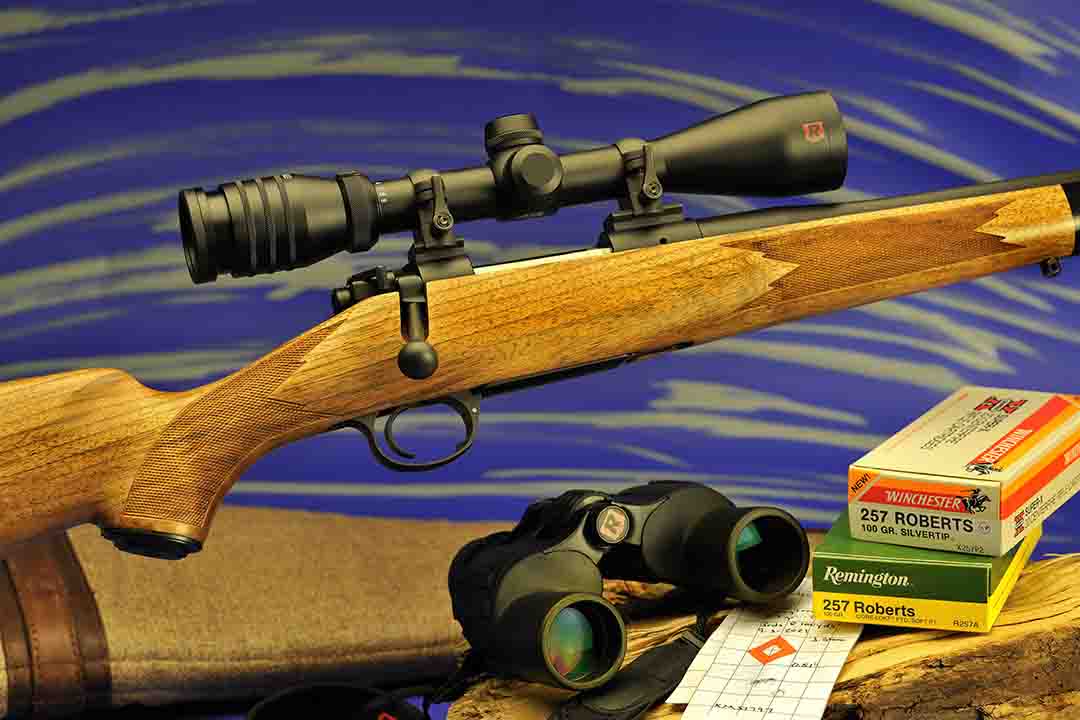
This photo shows the Kimber Classic Select with the Redfield 3-9x 40mm scope all mounted in Leupold detachable rings. Chambered for the almost forgotten .257 Roberts, this gun and cartridge is perfect as a deer and antelope plains rifle.
Some cartridges come and go, but when one comes along and proves its worth over the years, it sticks around. Such is the case of the classic .257 Roberts and combining it with a modern rifle like the Kimber 84M surely brings this vintage cartridge up to speed in our “hurry up, need it now world.”
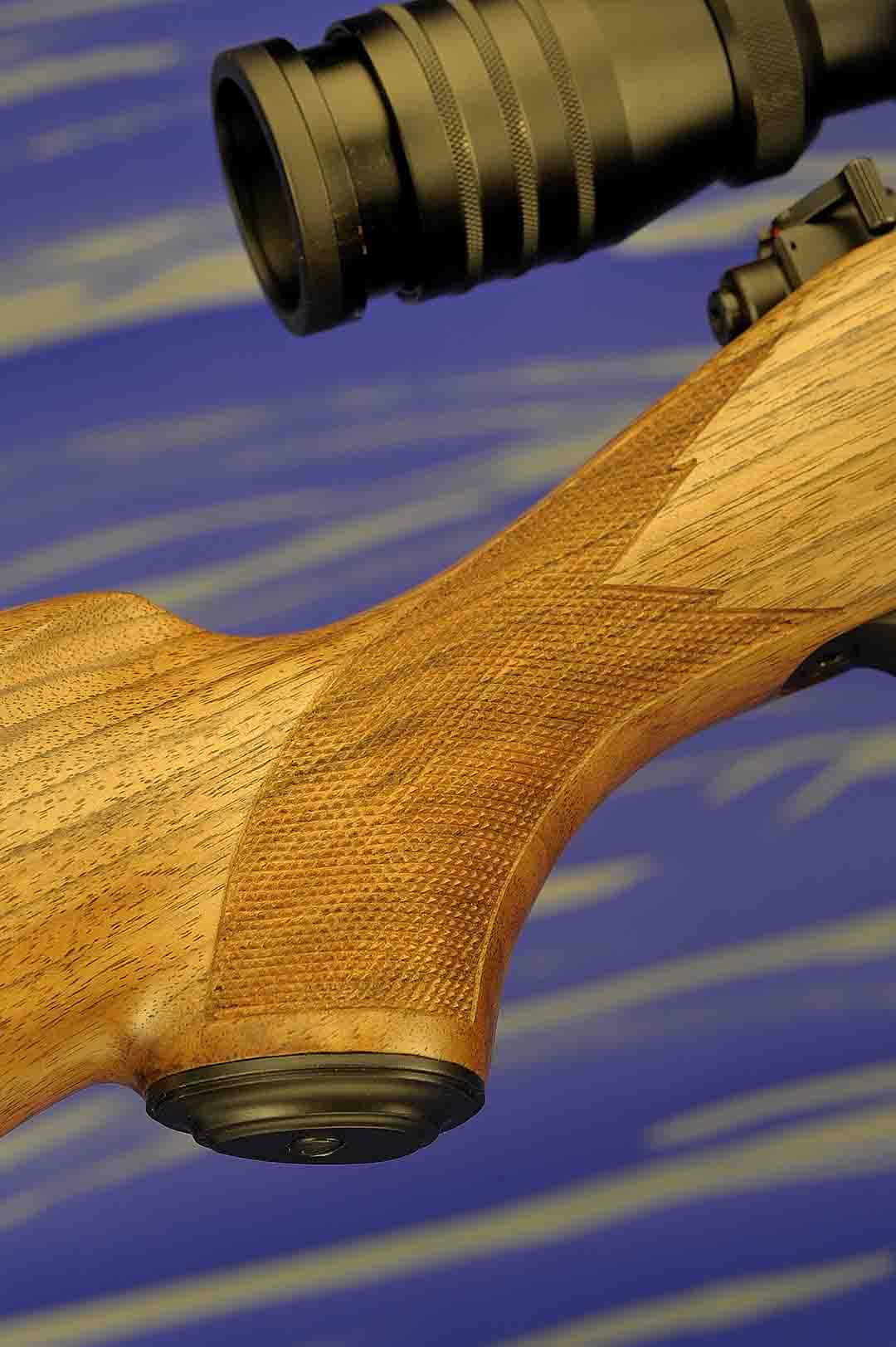
Fine line checking in a 20 lines-per-inch point pattern is standard on the model. More than an adequate design has been applied to both the pistol grip and forearm of the rifle. The metal grip also complements this part of the rifle.
As a typical New Englander, Ned Roberts proved to be a man of many traits. He loved hunting around his native New Hampshire and was active as a competitive target shooter, firearms experimenter and gun writer with a huge interest in the design of cartridges leading to the introduction of the .257 Roberts cartridge about a century ago. Being a dedicated wildcatter, he tried various avenues of bringing his new cartridge to light including using the .30-40 Krag and the .30-06 Springfield as a jumping-off point. Since the case of this pair was too big for the powders at the time favoring the .25 caliber and with even Townsend Whelen’s blessing on the project, friend Harvey Donaldson suggested the use of the parent 7x57 Mauser case as a better alternative. What started out as the .25 Roberts, Remington led to jumpstarting the cartridge in 1934 by modifying the shoulder angle from the original 15-degree Roberts design to a 20-degree angle by using the original 7x57 case and necking it down to receive a .25-caliber bullet.
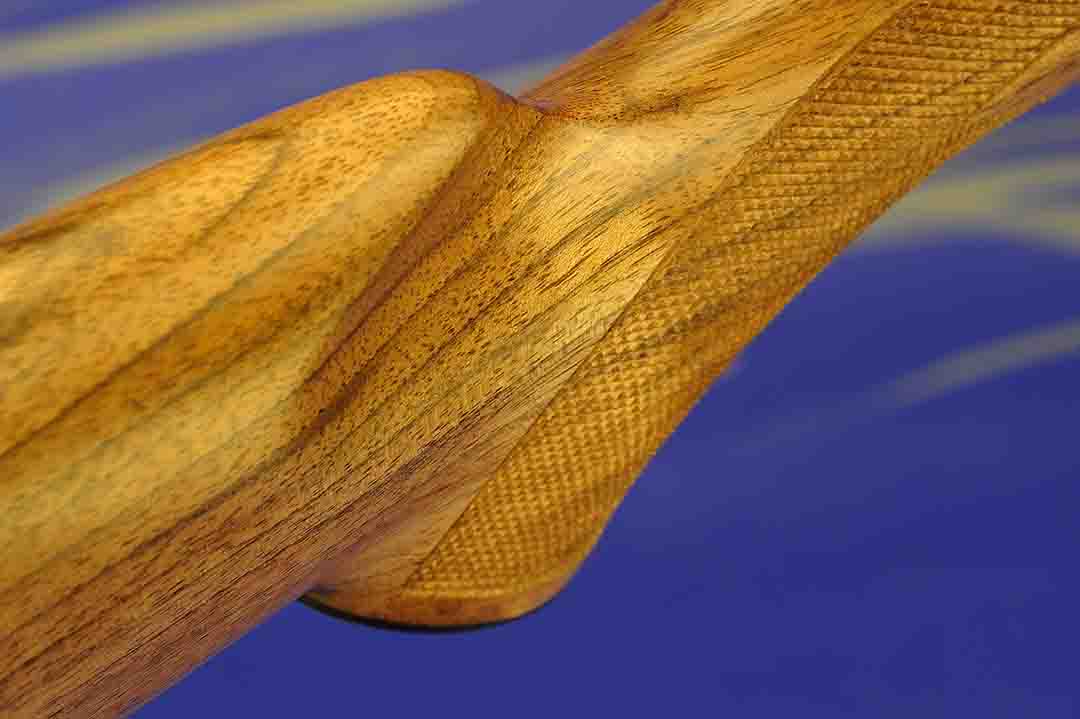
The pistol grip has been designed for shooter comfort as witnessed by this moderate swell near the base of the metal grip cap. Wide flares near the tang also help in locating the hand and act as a memory groove when picking up the gun.
In modern times, Remington has the knack for forecasting the future of wildcats like the .22/250 or the .25/06, and history shows that Remington, out of respect for Roberts, and the time he put into the development of the cartridge, named it the .257 Roberts. On the onset however, they made a misstep in loading the cartridge with the 117-grain roundnose bullet that lowered the velocity to almost .250 Savage levels. What looked like a premium cartridge for hunting, turned some sportsmen cold, and with the grim reaper knocking on the door with the onslaught of the 6mms, the Robert cartridge looked lost.
However, seeing the error in their ways, the cartridge was bumped up with new bullets and today, handloaders can squeak out more than 3,000 feet per second (fps) with a 100-grain bullet making it a good plains combination for deer and antelope. Interesting to note is that in The Complete Guide to Handloading by Philip Sharp, he has a listing using 41 grains of IMR-4064 (no velocity), but turning to the Hornady manual, they showed 39.2 grains of the same powder upping the ante to around 3,000 fps with a 100-grain bullet in a 22-inch barrel. Still another listing in Handloader No. 130 (November-December 1987) showed C.E. Harris loading the same bullet over 40 grains for a mean velocity of around 2,950 fps. Even back then, all parties were close to their goal in performance with this .25-caliber cartridge. Personally, I have hunted in Montana for this type of game with the Roberts and a Winchester Model 70 Featherweight with excellent results on all counts. By the way, if you find – in this new world of shortages – you can’t locate .257 Roberts brass, then necking down the 7x57 Mauser to .25 caliber will solve the problem in minutes.
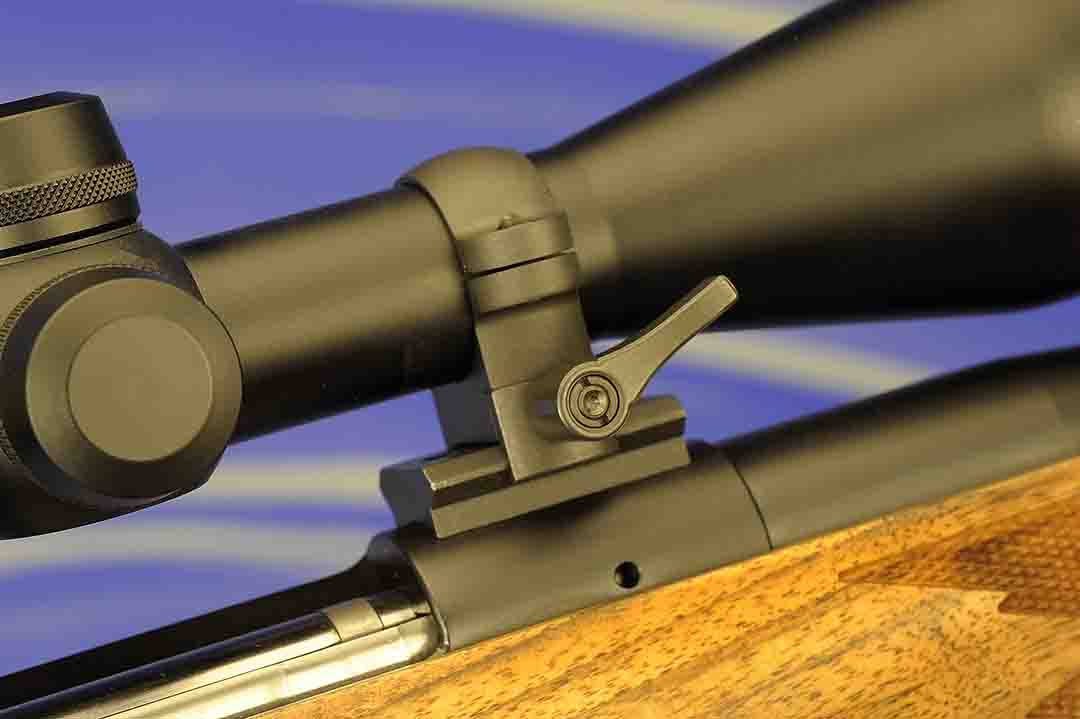
For the hunter who may want to separate the scope from the rifle on a long trip to prevent damage, Leupold detachable rings complement the rifle here. In practice, the levers are stored in the vertical position for shooting.
History aside, and regardless of the bad marks against the Roberts, over time riflemakers have had a love affair with this cartridge. In checking resources again, I found that Remington models 30-S, 722, 725, 700 and in 1982, had the Roberts in its popular “Classic” series. Winchester dabbled in the .257, as did Ruger with the Model 77, No. 1 and the Hawkeye on limited runs. Of course, custom makers like Griffin & Howe or Shaw still have requests for this caliber as well as the custom-production people like Cooper (15 models) and Kimber with the Classic Select and Hunter models.
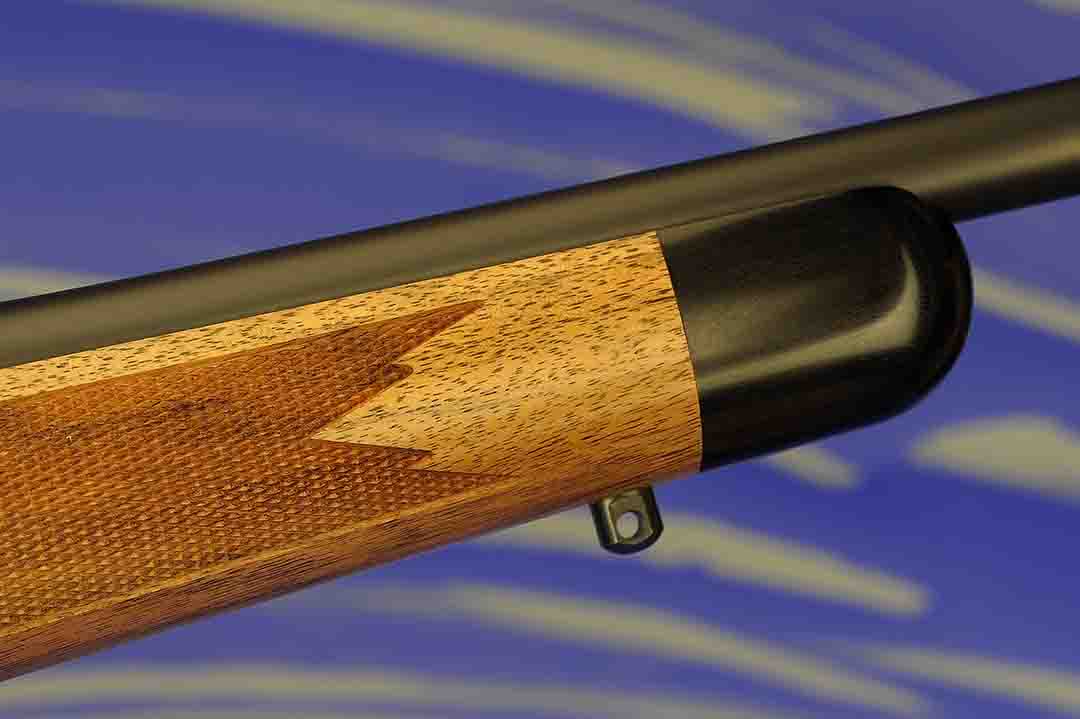
Typical of what a custom rifle is today, the ebony forend tip is cut at a 90-degree angle and attached without a white line spacer. Take note of the precise checkering pattern and the forward sling swivel stud.
For our report, the Kimber 84M Classic Grade gets the nod. To me, first impressions count, and out of the box, this gun is a winner. The lines are true, the design is solid and mounting the gun to my shoulder feels like the gun was made just for me. Profiled in a real classic fashion as the old masters would have it and put together in a fine blank of A-grade French walnut in a warm light tone complete with a hand rubbed oil finish, this gun has a lot going for it. Speaking of the finish, it is flawless to look at and so smooth to the touch I would almost have to say it was sprayed on.
Detailing the stock, I will start with the black ebony forend tip rounded off and cut at a 90-degree angle. At this point, inserting a piece of paper between stock and the barrel shows the gun has been free-floated for the best in accuracy and with a couple of three-shot test targets with Remington factory ammunition (0.51 and 0.72 inch) proved they are certainly doing the right thing. Just behind the tip, a sling swivel stud has been installed for field carry and slightly back, the point checkering pattern starts. Cut at 20 lines-per-inch, a closer look at both patterns on the gun (forearm and pistol grip) shows the forend checking has been cut much deeper than the latter. To me, this is a great idea as usually during hunting season, the shooter has gloves on and this technique in manufacturing allows a much more secure grip on the gun when shooting.
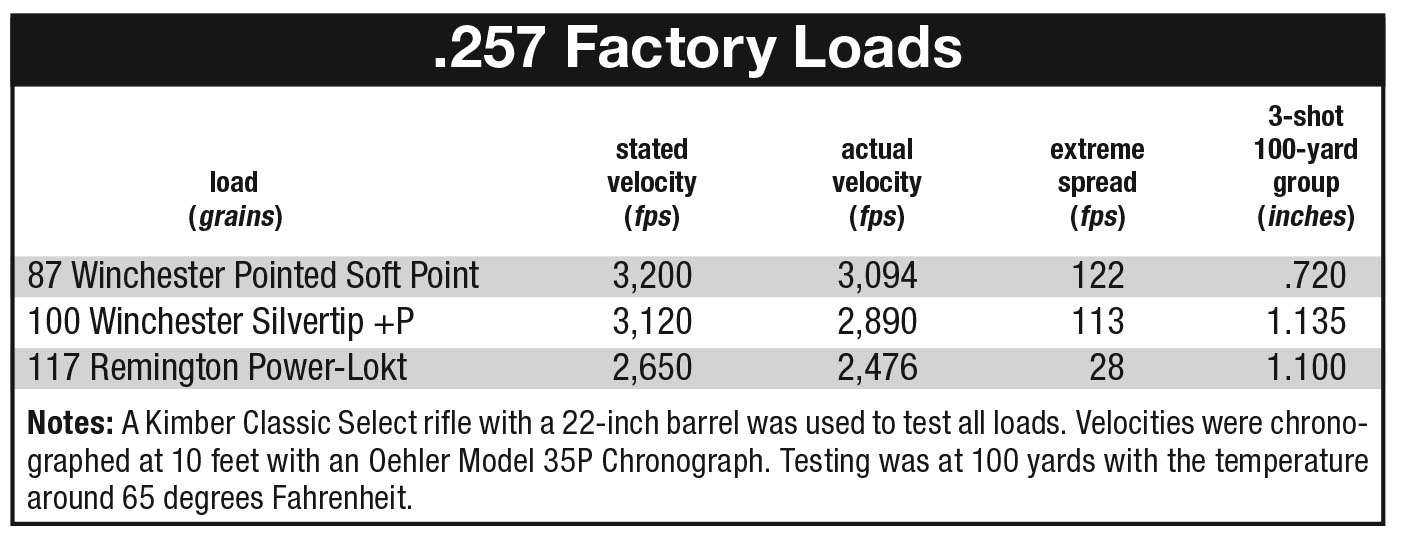
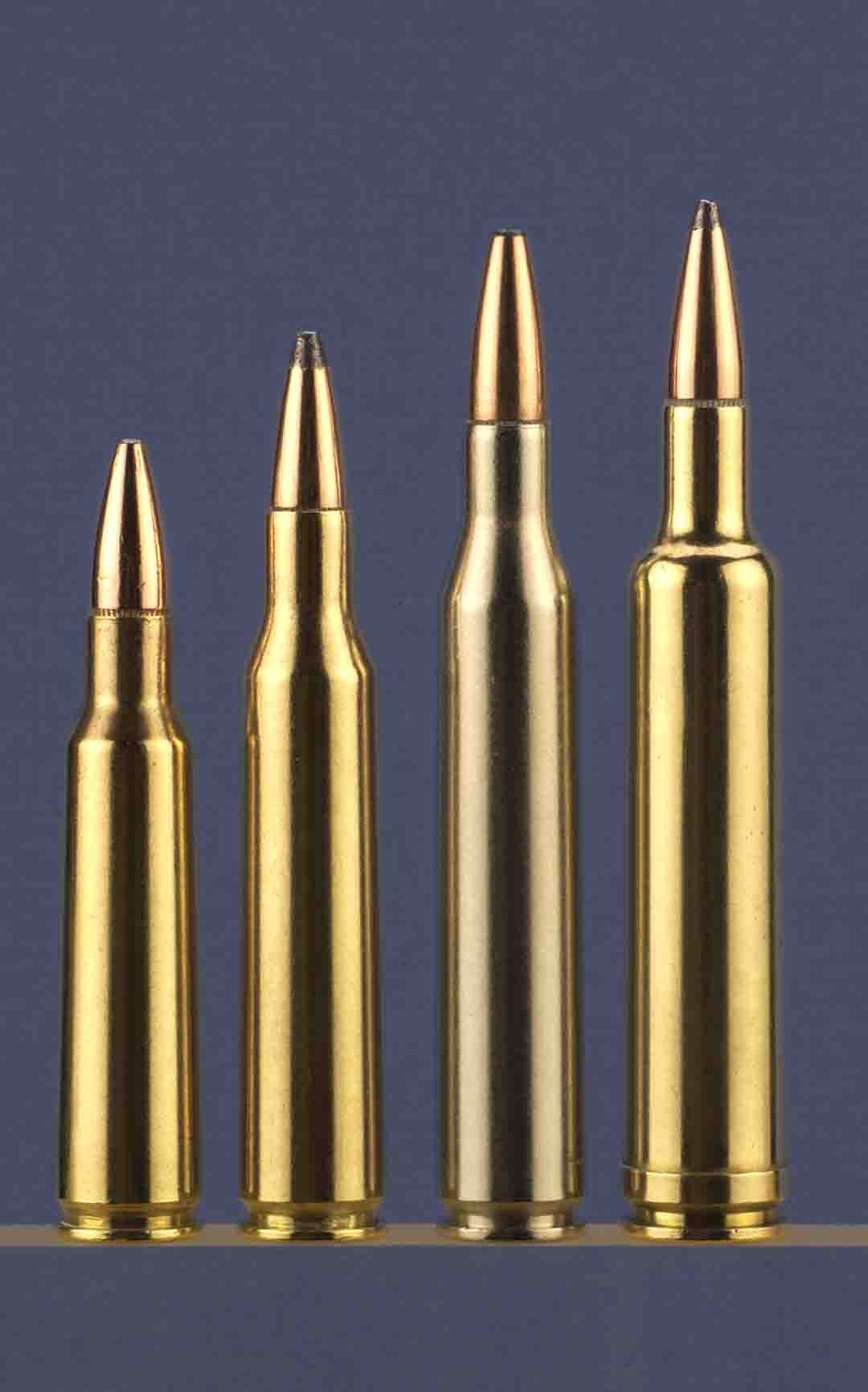
Here, we can see how the .25-caliber Roberts fits right in with both vintage and modern cartridges. From left to right, the .250 Savage, .257 Roberts, .25/06 Remington and the .257 Weatherby. Quite a choice for today’s shooter.
For a hunting gun, this part of the rifle is tapered just enough to hold the gun in a comfortable position for shooting. For me, the gun settled into the palm of my hand with my fingers almost touching the barrel. From there, the stock increases its width towards the receiver, bottom metal and the trigger group. The first thing I look for in a quality rifle is what materials are used and where they are on the gun. Usually the bottom metal (floorplate, spring, follower and trigger guard) is made from aluminum or a polymer material. On the Kimber, all this is steel, witnessed by the pulling power of my desk magnet and manufactured as only Kimber can do it followed by the words “Select Grade” tastefully inscribed on the surface. Freeing the floorplate to empty the gun is only a simple matter of pushing in the small magazine release within the trigger guard. Naturally, the trigger is adjustable and out of the box, my sample registered 4.25 pounds without the slightest bit of movement before the sear broke.
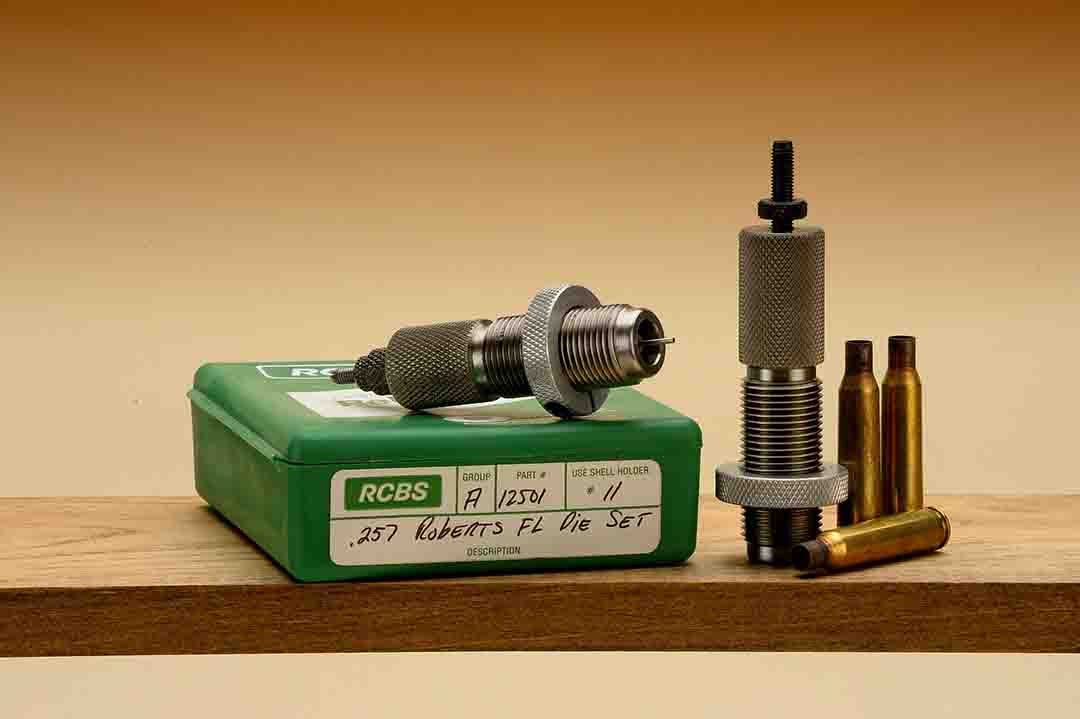
For the handloader, the .257 Roberts is a pleasure to load and shoot. While this test was conducted with factory ammunition, Stan has loaded the Roberts with more than satisfactory results with a variety of bullets and weights.
I would think that designing a rifle stock, the pistol grip is the hardest part to design considering the wide range of hunters out there and the size of their hands, if they wear gloves for cold weather hunting or finding that just right curve to be comfortable whether shooting from a rest, prone or offhand. On this rifle, the right combination has been found complete with the traditional point pattern checkering pattern all tuned to allow the gun to come up to point swiftly much like a good field grouse or quail shotgun. At the base of the grip, a steel grip cap has been installed in a teardrop design complimenting the rifle.
Above this, there is a flare in the stock on both sides, but sorry hunters, no left-hand gun from Kimber right now. I know that Kimber of Oregon made southpaw guns, as does Weatherby, Cooper, Remington, Savage and a few others, but for the present, nothing from Kimber. True to the classic school of thought, the comb is straight with a length of pull of 13.5 inches (Kimber quoted this as 13.63 inches) with a slight cast off to the right but with no line disturbing Monte Carlo rise or even a cheekpiece. This part of the buttstock is full and should accommodate most shooters regardless of the physical size of their face. Finishing off the stock is the customary sling swivel stud and a full 1-inch Pachmayr Decelerator recoil pad complemented with a black spacer fitting perfectly to this part of the gun. Inletting has been done with surgical precision around the barrel channel, receiver and the floorplate.
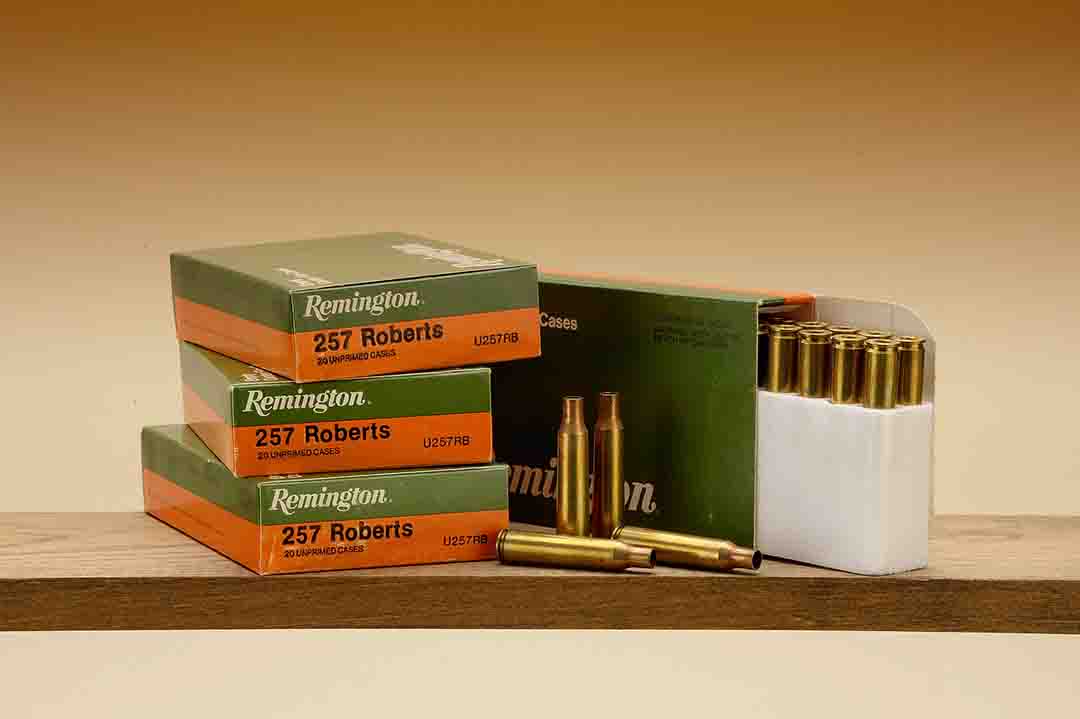
While .257 Roberts brass may be in short supply in gun shops, Stan found these four packages at a local gun show. Fresh out of the box makes for a good way to start using the Roberts. In a pinch, the 7x57 Mauser brass can be necked down to .25 caliber and works fine.
Turning to the action, I find it hard to fault. First, if I had to pigeonhole this gun, I guess it would (or could) fall into the popular mountain gun category but it would be equally at home in the thick, well-hunted woodlands of the East. To this, I add the lightweight, 22-inch sporter barrel profile with a match grade chamber that keeps the gun around 5.5 pounds sans ammunition, scope and rings even with the whole assembly machined from solid steel finished in a rich satin blue. The bolt is patterned after the trusted Mauser design with controlled round feeding and a claw extractor and with a diameter of .590 inch, is the perfect choice for the .257 Roberts. Incorporated in all this are twin-locking lugs up front with a rear lug machined in for safety and a no nonsense bolt handle with the bolt release on the left side of the gun. Typical of Kimber, the close surfaces on all the lugs have been honed by hand to add to the smoothness of the bolt when closing.
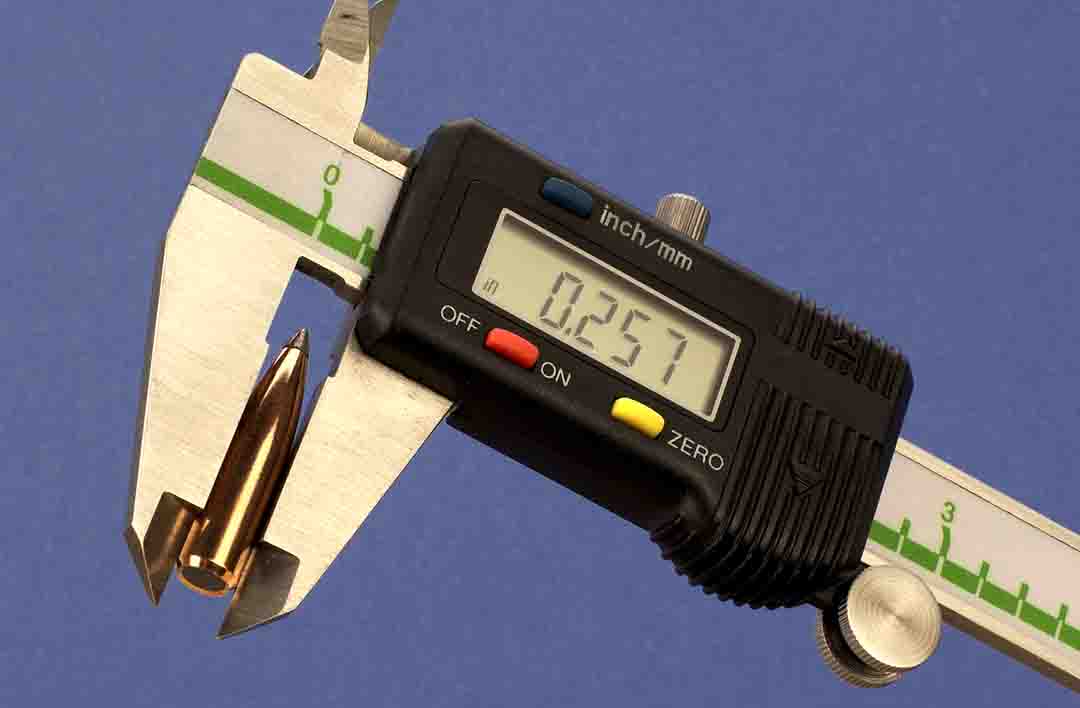
With all the cartridges made today in the popular .25 caliber, the Roberts can provide a lifetime of shooting, making up loads along the way, all combined with fine hunting experiences with a truly classic cartridge.
The receiver has been proportioned to cartridges like the .257 Roberts and others like the .243 and .308 Winchester. Inside, the action is both pillar and glass bedded and open topped, thus allowing the shooter to insert cartridges at will if the magazine runs dry. There are no open sights on the gun, so the receiver is drilled and tapped for popular scope bases. For range testing, I added a Redfield Revenge Hunter 3-9x 40mm scope in Leupold detachable rings. The Winchester Model 70 type of safety is three-position with to the rear locking everything up, while mid-position allows the shooter to work the bolt to load or unload ammunition and forward to fire.

On a photo trip to Montana, Stan was able to get close enough with a long lens to capture images of pronghorn antelope. Combined with mild recoil and good accuracy, the .257 Roberts, in Stan’s opinion, is a great cartridge for this type of plains game. He has three on his wall to prove it!
Going by the reputation of Kimber rifles, I was not disappointed at the range. According to their literature, Kimber guarantees sub-minute of angle accuracy with factory loads and I did come very close to that statement. These are the best of the groups fired with the Winchester and Remington ammunition at 100 yards. I did match one of their groups (.720 inch) with the Winchester 87-grain PSP sample at .720 inch but the other ammunition came a bit over the one-inch mark. Still no problems, I’m more than happy with that especially with a new rifle right out of the box.
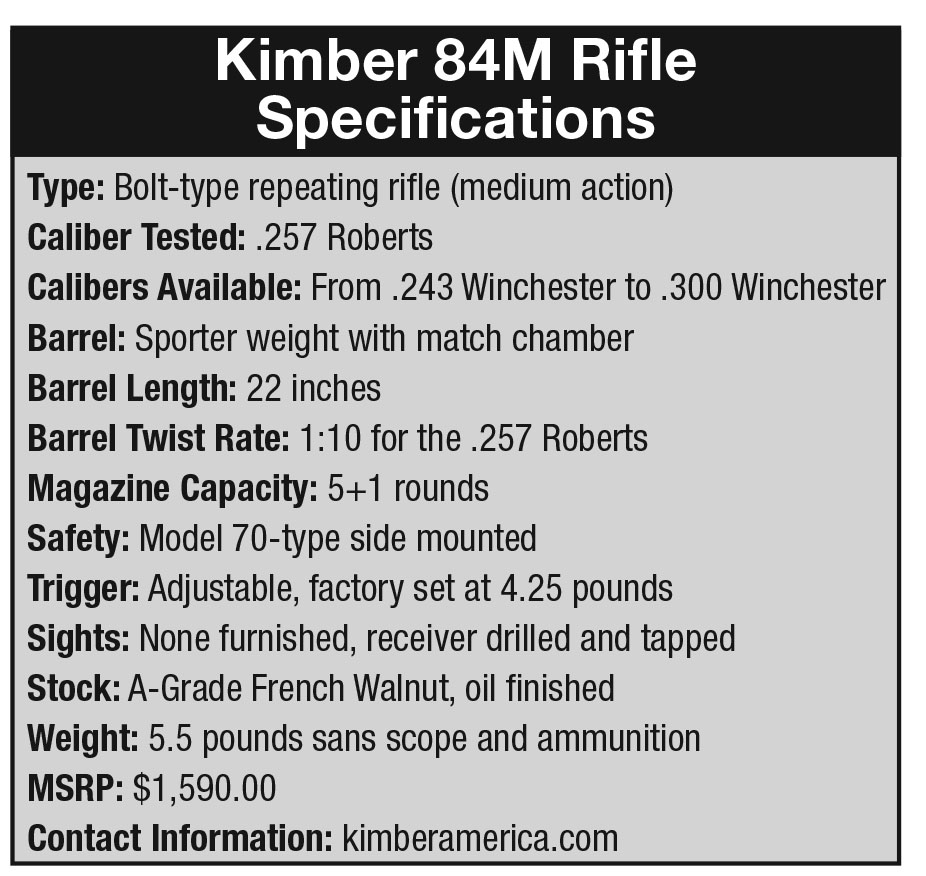
In regard to shooting the Roberts in a lightweight rifle and since I’m used to using a heavier 8.5-pound rifle, it did offer a moderate feeling at the shoulder but it was not that much of a concern. If one weighs the mass of the rifle against carrying it all day in the field, I’ll take the extra recoil sensation with a one-shot kill any day especially with the .257 Roberts. The operation of the gun was flawless, as it ejected spent cartridges to my right with enthusiasm, while feeding and loading was problem-free and the trigger – well, perfect!
Overall, I have nothing but praise for this Kimber product. The detailing and workmanship are first-rate, while the price is more than fair for a “custom-production” rifle, a buyer has a wide choice of cartridges with a host of different models and to top it all off, it is accurate.
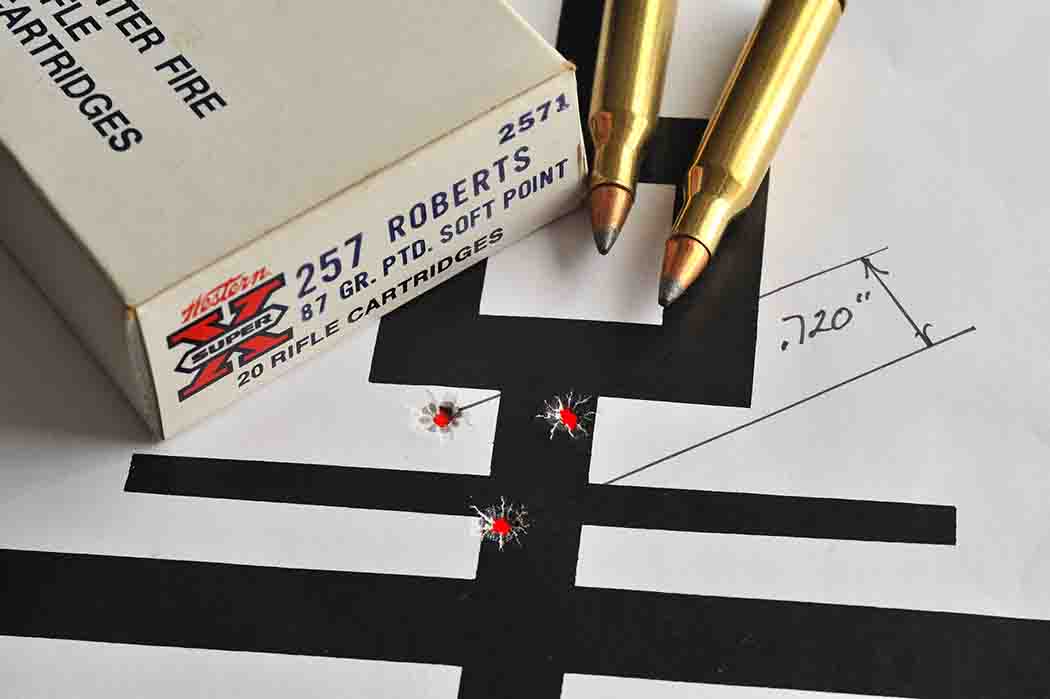
When it came to testing the Kimber, for Stan, it’s hard to match the factory targets, but this Winchester 87-grain Pointed Soft Point did match one of the samples sent to him at 100 yards.
Come next hunting season, you should have one on your shoulder.














